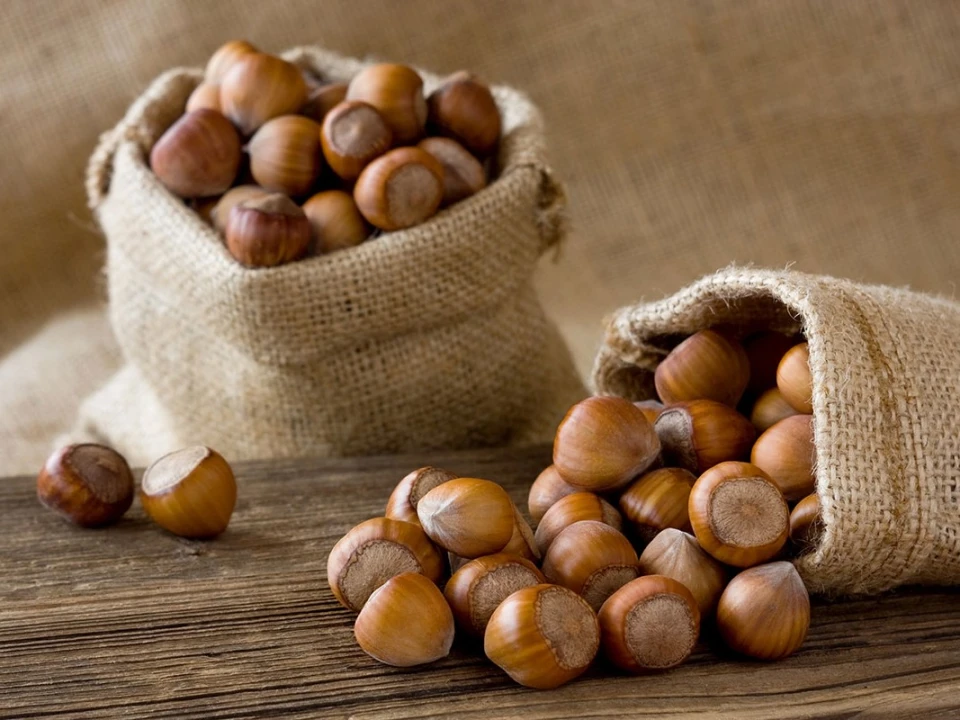The hazelnut, widely found in all temperate regions of the northern hemisphere, was one of the first fruit trees to be used and cultivated by humans, providing an important source of energy for early nomadic populations. Research carried out in past years has shown that the hazelnut was already present in the historical cultivation areas of Piedmont during the ancient Roman era.
In more recent times, the cultivation of this nut expanded considerably during the 1960s and ‘70s, due to increasing demand for the product by the local confectionery industry. This led to a renewed interest in hazelnuts among the farmers operating in these areas, with a constant increase in cultivation up to the present day.
When an enterprising chocolate maker in Turin recognised the potential of the hazelnut, he developed the first recipe for gianduja: a traditional speciality in which the aroma, taste and texture of this nut from Piedmont are expressed to perfection together with exotic cocoa. Chocolate with hazelnuts, either whole or crushed, has grown from being a regional speciality to become a symbol of delectability even abroad: it is an entirely unique emblem, which the Italian confectionery industry offers to the world market as an exquisite example of its time-honoured culture.
The Product
The hazelnut variety grown in Piedmont is the Tonda Gentile Trilobata. Its production is concentrated in the provinces of Cuneo, Asti and Alessandria, in an area between the hills of the Langhe, Roero and Monferrato. The PGI designation assures users and consumers of the product’s quality and authenticity.
The IGP Nocciola Piemonteis particularly appreciated by the confectionery industry due to the roundness of its kernel, its excellent taste and aroma after toasting, its ease of shelling and good shelf life. Thanks to these qualities, the Nocciola Piemonte is universally recognised as the best in the world.
To prevent fallen ripe fruit from absorbing moisture on the ground and deteriorating, harvesting needs to be done rapidly and repeatedly. This ensures that the shelled hazelnuts provide a high yield and good quality. Cuneo, with its 7,000 hectares of land planted with hazel trees, provides nearly 85% of the production in Piedmont.
The protected geographical indication has been recognised, with EC regulation of the name “Nocciola Piemonte” limited to the “Tonda Gentile Trilobata” variety cultivated in specified territory of the Piedmont region.
Today, production in Piedmont, with its significant capacity for industrial processing, which makes it very significant in economic terms, amounts to almost 150,000 quintals, which is about 8-9% of the national total.
The Local Area
The PGI Nocciola Piemonte can only be produced in certain areas of the Piedmont region, including the provinces of Alessandria, Asti, Biella, Cuneo, Novara, Turin and Vercelli, as described in detail in the production rules.
Eighty-five per cent of the hazel orchards involved are concentrated in the Langhe area of the province of Cuneo.
The cultivation area with its particularly favourable soil and climate conditions, together with the hazel-growing tradition and culture, are a combination that has enabled the Tonda Gentile Trilobata hazelnut, grown in Piedmont, obtain European recognition as the “PGI Piedmont Hazelnut”. Several studies carried out by internationally recognised laboratories have justifiably described it as the world’s best hazelnut.
Health
In addition to containing significant essential amino acids and vitamin E, hazelnuts are particularly rich in lipids, with a caloric intake of 700 Kcal per 100 g of dry product.
In particular, the lipid fraction is composed of over 40% monounsaturated fatty acids (such as oleic acid) and has a higher ratio of monounsaturated to polyunsaturated fats than any other dried fruit. Recent studies appear to confirm the positive effects of regular consumption of hazelnuts on human health.
It has been shown that a diet rich in oleic acid (the same fatty acid found in extra virgin olive oil) lowers “bad cholesterol” levels in the blood and raises the levels of “good cholesterol”, which provides important defence from vascular disease, helping to protect cell membranes. Due to their high tocopherol content, including vitamin E, hazelnuts also provide a substantial intake of antioxidants that help reduce tissue ageing.
The chemical and physical composition of hazelnut oil, which is very similar to that of extra-virgin olive oil, confirms the abundant nutritional properties of this fruit. The Nocciola Piemonte in particular, which has a higher oil content than other Italian and foreign varieties (about 70%), is proven to be a valuable, high-quality food product.
By Consorzio Tutela Nocciola Piemonte




